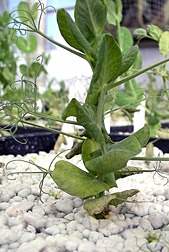This page has been archived and is being provided for reference purposes only. The page is no longer being updated, and therefore, links on the page may be invalid.
| Read the magazine story to find out more. |
|
|
Disease-resistant Peas Developed for Release
By Jan Suszkiw
November 21, 2013
New garden- and dry-pea breeding lines developed by U.S. Department of Agriculture (USDA) scientists and their collaborators may offer growers added insurance against Aphanomyces root rot, a disease that can cause crop yield losses of 20 to 100 percent.
The mold-like pathogen that causes the disease, Aphanomyces euteiches, infects the roots and underground stems of susceptible pea plants and other legumes, rotting them and causing stunted growth, lesions, wilted leaves and other symptoms. Fungicides aren't an option, so growers must either avoid planting in fields with a history of the disease or switch to growing non-host crops until pathogen numbers drop to acceptable levels.
However, avoidance and crop rotation may not always be economically feasible. Furthermore, breeding peas for resistance to Aphanomyces has proven difficult because multiple genes are involved, according to Rebecca McGee, a plant geneticist with USDA's Agricultural Research Service (ARS), USDA's principal intramural scientific research agency.
The resistance genes are also associated with undesirable traits, which cultivated varieties can inherit when crossed with wild germplasm sources, adds McGee, at the ARS Grain Legume Genetics Physiology Research Unit in Pullman, Wash.
As an alternative, McGee, ARS geneticist Clare Coyne and other colleagues sought to develop pea germplasm lines that naturally tolerate the pathogen, but do not suffer the same ill effects as susceptible plants—particularly not significant yield losses. Coyne is with the ARS Plant Germplasm Introduction and Testing Research Unit, also in Pullman.
The pea lines are descendants of an inbred population of plants derived from an ARS cross made in 1993 between the cultivar Dark Skin Perfection and germplasm line 90-2131. Besides their tolerance of Aphanomyces root rot, the lines were also chosen for their acceptable agronomic characteristics.
Incorporating the tolerance trait into elite varieties could prove especially beneficial to growers in Pacific Northwest and North Central states, where Aphanomyces outbreaks threaten the valued role that peas and other legumes play in cereal-based crop rotation systems.
Read more about this research in the November/December 2013 issue of Agricultural Research magazine.

